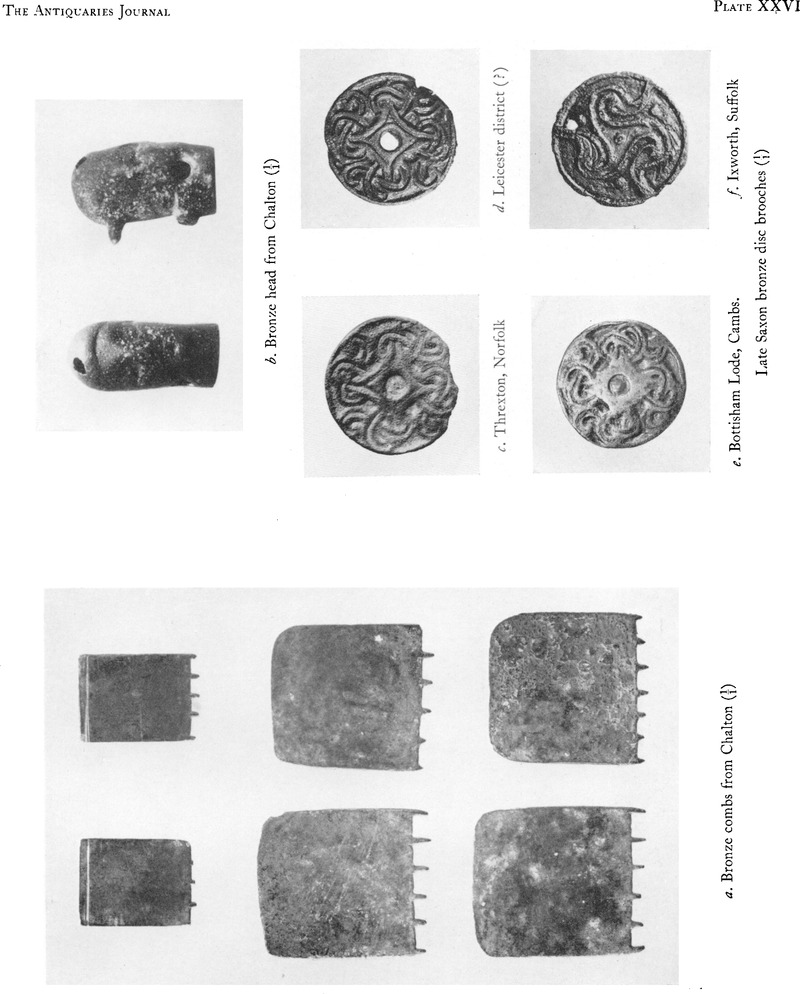No CrossRef data available.
Published online by Cambridge University Press: 29 November 2011

page 220 note 1 Berichten van de Rijksdienst voor het Oudheid-kundig Bodemonderzoek in Nederland, iv, ii, 31–32, figs. 11–12, pl. IV, 4.
page 220 note 2 For an earlier partial analogue, see Bull. Soc. Suisse de Prehistoire (1952), 121, from Eschen.Google Scholar
page 220 note 3 Mr. G. C. Dunning, F.S.A., tells me that he has recently found a similar bronze object with three teeth and with a single rivet-hole at the other end among surface finds from inside the SW. area of the Saxon Shore-Fort at Richborough.
page 220 note 4 Antiq. Journ. xxxvi, 70–71, pl. viiia.
page 220 note 5 C. R. Smith, Coll. Ant. iii, pl. xxxiv. 8; V.C.H. Norfolk, i, 347; Norfolk Archaeology, iv, 363 and 354, fig. 5. Castle Museum, Norwich.
page 220 note 6 Leicester Museum.
page 220 note 7 Reg. No. 1942, 10–8 17.Google Scholar
page 220 note 8 I am grateful to Mr. G. C. Dunning for giving me information on these last two examples.
page 220 note 9 V.C.H. Cambs. i, 322, no. 7, pl. xiie; C.A.S. xxix, 113; Shetelig, H., Viking Antiquities in Gt. Britain and Ireland, iv (1940), 69, fig. 42. The present whereabouts is here given as Ashmolean Museum, but it is in the possession of the Museum of Archaeology and Ethnology, Cambridge, no. 25, 607.Google Scholar
page 221 note 1 Dr. G. F. Claringbull has kindly tested this material and states that its identification is doubtful so far, but it is neither niello nor enamel. There is copper oxide (CuO) present.
page 221 note 2 Petersen, J., Vikingetidens Smykker (1928), p. 123, fig. 131.Google Scholar
page 221 note 3 V.C.H. Suffolk, i, 348.
page 221 note 4 Moyses Hall Museum, Bury St. Edmunds, Suffolk; V.C.H. Suffolk, i, 336, where it is compared with a similar brooch in the British Museum.
page 221 note 5 I am very grateful to the Leicester Museum, Castle Museum, Norwich, Moyses Hall Museum, Bury St. Edmunds, and the Museum of Archaeo logy and Ethnology, Cambridge for permission to publish photographs of these brooches. Visits to these museums were made possible by a grant from the Central Research Fund, University of London.
page 221 note 6 Arbman, H., Birka I (1940), Taf. 71.13.Google Scholar
page 221 note 7 I am indebted to Dr. W. Holmqvist for giving me his opinion on the date of this grave.
page 221 note 8 H. Arbman, op. cit., Taf. 71.
page 221 note 9 Brøndsted, J., Early English Ornament (1924), 146.Google Scholar
page 221 note 10 Ibid., fig. 92.
page 221 note 11 Ibid., fig. 93 panel in loop of Q
page 221 note 12 Leeds, E. T., Early Anglo-Saxon Art and Archaeology (1936), pl. xviii c, d, f, pl. xxxi.Google Scholar
page 222 note 1 B. Nerman, ‘Gravfunden på Gotland under tiden 550–800 E.K.’, Antikvarisk Tidskrift för Sverige, 22, fig. 45.
page 222 note 2 H. Arbman, op. cit., Taf. 70, 2, 3, 4, 7, and Taf. 71, 5; ibid., Schweden und das Karolingische Reich (1937), Taf. 51; etc.
page 222 note 3 J. Petersen, op. cit., fig. 124.